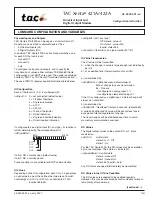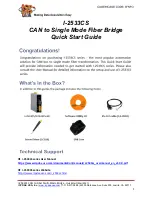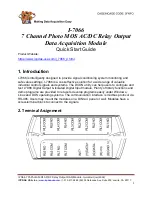
5-9
At high current levels, even a single conductor can generate
significant fields. These effects can be minimized by using
twisted pairs, which will cancel out most of the resulting
fields
Radio frequency interference
Radio Frequency Interference (RFI) is a general term used to
describe electromagnetic interference over a wide range of
frequencies across the spectrum. Such RFI can be particu-
larly troublesome at low signal levels, but it can also affect
measurements at high levels if the problem is of sufficien
severity.
RFI can be caused by steady-state sources such as radio or
TV signals or some types of electronic equipment (micropro-
cessors, high speed digital circuits, etc.), or it can result from
impulse sources, as in the case of arcing in high-voltage envi-
ronments. In either case, the effect on the measurement can
be considerable if enough of the unwanted signal is present.
RFI can be minimized in several ways. The most obvious
method is to keep the equipment and signal leads as far away
from the RFI source as possible. Shielding the Model 7037
relay-digital I/O card, signal leads, sources, and measuring
instruments will often reduce RFI to an acceptable level. In
extreme cases, a specially constructed screen room may be
required to sufficiently attenuate the troublesome signal
Many instruments incorporate internal filtering that may
help to reduce RFI effects in some situations. In some cases,
additional external filtering may also be required. Keep in
mind, however, that filtering may have detrimental effects on
the desired signal.
Ground loops
When two or more instruments are connected together, care
must be taken to avoid unwanted signals caused by ground
loops. Ground loops usually occur when sensitive instru-
mentation is connected to other instrumentation with more
than one signal return path such as power line ground. As
shown in Figure 5-9, the resulting ground loop causes cur-
rent to fl w through the instrument LO signal leads and then
back through power line ground. This circulating current
develops a small, but undesirable, voltage between the LO
terminals of the two instruments. This voltage will be added
to the source voltage, affecting the accuracy of the measure-
ment.
Figure 5-10 shows how to connect several instruments to-
gether to eliminate this type of ground loop problem. Here,
only one instrument is connected to power line ground.
Figure 5-9
Power line ground loops
Figure 5-10
Eliminating ground loops
Instrument 1
Instrument 2
Instrument 3
Power Line Ground
Signal Leads
Ground Loop
Current
Instrument 1
Instrument 2
Instrument 3
Power Line Ground
Summary of Contents for 7037
Page 7: ......
Page 33: ...Card Connections and Installation 4 14...
Page 61: ......
Page 62: ......
Page 63: ......
Page 64: ......
Page 65: ......
Page 67: ......
Page 68: ......
Page 72: ...Keithley Instruments Inc 28775 Aurora Road Cleveland Ohio 44139 Printed in the U S A...
















































